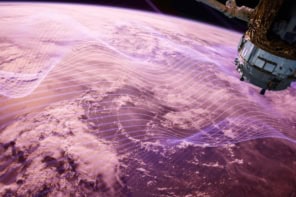
In February 1986 the passenger ship SS Spray was travelling along the east coast of the US when it was suddenly hit by a wave that was estimated to be 17 m high – the second in a system of three consecutive “rogue waves” that were much higher than normal ocean swells. The ship suffered some minor damage and took on some water – although passengers and crew were shaken, all aboard survived. Now an international team of physicists has explained how these terrifying waves could suddenly appear in the middle of the ocean.
Mariners have long known that such waves are more prevalent in regions of strong ocean currents – the Gulf Stream in the case of the SS Spray. However, physicists have struggled to explain the physical connection between current and waves. But now Miguel Onorato and colleagues at the University of Turin in Italy and the Swinburne University of Technology in Australia have done computer simulations that show how rogue waves can form when normal ocean waves encounter a strong current moving in the opposite direction.
The work is based on the idea that such a pulse of three or four giant waves can be described mathematically as a “breather”, which is an exact solution of the nonlinear Schrödinger (NLS) equation. Not to be confused with its quantum cousin, the NLS applies to classical physics including water waves and optics.
Focused into a breather
The team began the simulation with the sort of plane waves that you might encounter on the ocean – swells with an amplitude of 2.5 m that propagate in a specific direction. These waves then encounter a current that is flowing in the opposite direction. When the plane waves travel from a region of no current to a region with a current, they cross a current gradient. The simulations show that the encounter with the gradient causes the energy of the plane wave to be focused into a small region. This causes instability in the plane wave, which triggers the appearance of a breather.
The simulations suggest that breather formation could occur when plane waves with a period of about 10 s – a typical condition in a storm – encounter a current travelling at about 1.5 m s–1, a speed not unknown for ocean currents.
Efim Pelinovsky of the Institute of Applied Physics at the Russian Academy of Sciences agrees with the team’s analysis of how the breathers could form, and points out that the process could occur in regions where the prevailing winds move in the opposite direction as the current. This condition is commonly seen in the Indian Ocean off the coast of South Africa, where the Agulhas Current has long been associated with rogue waves.
Onorato told physicsworld.com that researchers working in Tokyo have already done experiments in wave tanks that back up the simulations. Because the NLS also applies in optics, Onorato says that the effect should also be seen in experiments with light. Instead of a current, a breather should be formed when light waves travel through an optical fibre along which certain nonlinear properties change gradually.
The work is reported in Phys. Rev. Lett. 107 184502.



